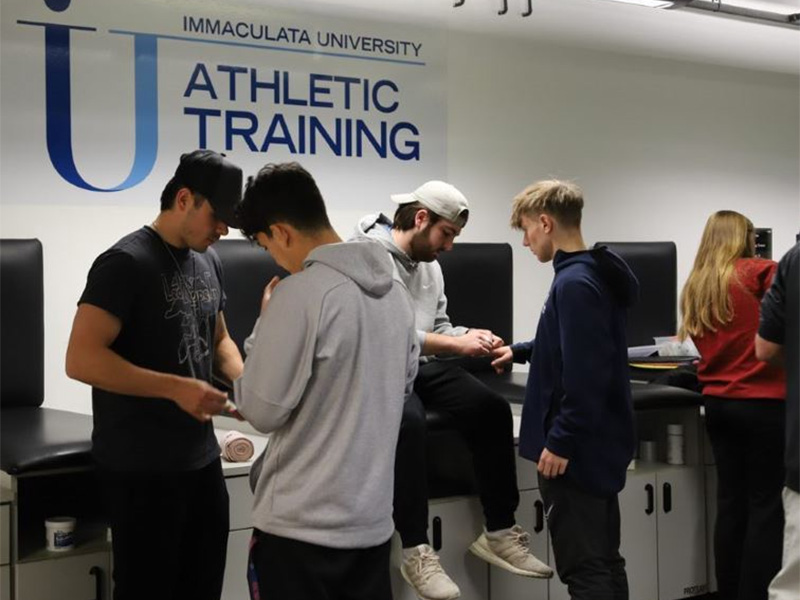
A Q&A with Immaculata University Athletic Training Program Director Kelly A. Stalker, Ed.D., LAT, ATC
How has the field of athletic training changed in the past decade?
There have been so many changes in the field of athletic training over the past 10 years. The most obvious change is the requirement of a master’s degree in athletic training to sit for the board of certification examination. This decision was made due to the changing landscape of higher education and health care. Along with this change, the scope of practice for athletic trainers has broadened in many states. Entry-level athletic trainers are now prepared with a skill set that is more advanced based on the current Commission on the Accreditation of Athletic Training Education (CAATE) education standards. Over the past decade there has been an increased focus on concussion prevention, assessment, and treatment; youth sport safety; and profession advocacy.
When the NFL’s Buffalo Bills’ player, Damar Hamlin, almost died on the football field and was rescued by the team’s athletic trainers, how did that incident impact the profession?
Despite the severity of this incident, the media coverage brought the athletic training profession into the spotlight. The medical team, including the athletic training staff, were acknowledged for their quick and efficient response to the situation. Certified Athletic Trainer, Denny Kellington, was recognized as the individual providing CPR on the field and ultimately saving Hamlin’s life. The nationwide coverage of this extremely intense experience showcased athletic trainers as the primary line of defense in injury and emergency care. Situations like this unintendedly allow for advocacy for the profession and further prove the need for athletic trainers at all levels of athletic participation.
When you watch sports, either in person or on TV, what are your immediate thoughts when a player is injured?
My reaction is dependent on the severity of the injury, which is often initially assessed by the sounds that are heard and the way the individual falls to the ground. Even when I am not the athletic trainer on the field providing coverage, I am still in athletic trainer mode and start immediately trying to gather information about the potential injury and immediate care actions. When watching sports on TV, I am immediately looking for a replay to show the mechanism of injury to determine the direction of force and potential structures that may have been affected.
It seems like sports organizations are taking player safety more seriously than in the past. Do you think that’s true and if so, why?
Professional organizations have always been concerned with player safety, but over time, we have learned more about the cause of injuries and lasting effects. This has resulted in annual rule changes and altered medical protocols. Safety rule changes go back to the late 1800s when the “Flying V” or “Flying Wedge” formation in football was outlawed due to the high number of injuries incurred. Every five years, the International Conference of Concussion in Sport reviews current concussion assessment protocols and publishes an updated statement. This summer the Sport Concussion Assessment Tool-6 (SCAT-6) was released with significant revisions from the previous tool, including an office assessment tool and additional coordination and balance assessments.
You’ve stated that athletic trainers are the first line of defense. Can you explain how their training provides for this level of preparation?
Athletic trainers must graduate from an athletic training program that is approved by CAATE and pass a national certification examination. All education programs follow a competency-based approach to prepare future athletic trainers in the five domains of athletic training: 1.) Risk Reduction, Wellness and Health Literacy, 2.) Assessment, Evaluation, and Diagnosis, 3.) Critical Incident Management, 4.) Therapeutic Intervention, and 5.) Health Care Administration and Professional Responsibility. Athletic trainers are trained to care for emergency situations such as traumatic brain injury, spinal injury, cardiac and/or respiratory arrest, heat illness, mental health crisis, etc. Annually, athletic trainers review their Emergency Action Plans to ensure effectiveness and practice necessary skills with the entire medical team. Every two years, athletic trainers need to submit a minimum of 50 hours of continuing education and update their CPR/AED certification (minimum level of professional rescuer or Basic Life Support). During the education process, athletic training students learn and practice emergency care skills such as wound care, application of tourniquets, suturing, heat illness management, spinal stabilization, and care for cardiac or pulmonary compromise, including CPR, AED, and insertion of external airways.
What are some important traits for an athletic trainer to have?
Athletic trainers need to possess the ability to multi-task, manage their time, and be organized. In the everyday life of an athletic trainer, they are working with multiple patients simultaneously. At any given time, there are individuals in the facility for an injury/illness evaluation, while there are also multiple individuals receiving treatment or completing their rehabilitation protocols. During this time, the athletic trainer needs to be able to work with all patients, while prioritizing the most critical and complete all of this in a timely fashion to allow individuals to return to activities on time. Additionally, it is imperative that athletic trainers have good communication and listening skills. They must communicate with patients, other medical staff, specialty physicians, coaches, athletic directors, supervisors, and parents/care givers. While performing an evaluation, athletic trainers need to be critical thinkers and listen to everything the patient states. I often compare the role of an athletic trainer to that of a detective. You need to take all of the pieces of information provided and put them together like a puzzle or use the clues to solve the mystery in order to determine a diagnosis for the patient. Finally, it is important for an athletic trainer to be creative. Not all patients and conditions are alike. There are many protocols and procedures for treatments, but not all patients respond to them in the same way.
Immaculata offers a master’s degree in athletic training. How vital is it for students to continue their education in this field?
The athletic training profession switched the professional degree requirement to a master’s degree starting in 2022. Therefore, in order to become certified and practice as an athletic trainer, students need to obtain a master’s degree from a CAATE-accredited athletic training program, like the one we offer at Immaculata. This transition is still fairly new, so it is hard to say approximately what percentage of individuals will continue their education onto doctoral degrees or the newly established residency programs. However, all athletic trainers need to participate in continuing education and submit their learning experiences to the Board of Certification (BOC) every two years to maintain their certification. Therefore, athletic trainers are always learning and growing to stay up to date in the latest research and techniques within the field.
Besides working for a sports team, what other jobs can graduates pursue?
According to the National Athletic Trainers’ Association (NATA), the majority of athletic trainers are employed in traditional school settings. Twenty-four percent are employed in the college/university setting, and 24% are at secondary schools. Middle schools are grouped with secondary schools, but more and more school districts are hiring athletic trainers for their middle school sports. In addition to these settings, 16% of athletic trainers are in the clinic or hospital setting, and only 3% are in professional sports. Approximately 3% of athletic trainers are employed in what we refer to as emerging settings, which include performing arts, public safety (police, fire, etc.), military and occupational health. One of our alumnae is employed as an Early Intervention Specialist at a cosmetic company. In this role she manages on-site injuries and even saved a man’s life by performing CPR.
What advice would you give to a student considering a career as an athletic trainer?
Athletic training is a rewarding profession in which you develop a strong professional rapport with your patients. Athletic trainers are part of the process from injury prevention through return to participation, making athletic training unique compared to many other health care professions. To be successful as an athletic trainer, students need to have a strong interest in and understanding of science and the human body. The general population often perceives the profession as providing water, giving ice, and taping, but there is much more involved than those basic tasks. This is a profession for individuals who have an interest in health care, want to make an impact in the lives of others, enjoy a high-paced environment, and most importantly do not mind working with blood, bodily fluids and feet.
What makes Immaculata’s graduate programs in athletic training different from other colleges that offer similar majors?
Immaculata University’s Master of Athletic Training (MAT) program offers six clinical education experiences, starting in the student’s second semester of the program. Two of these experiences are immersive experiences in which students participate in full-time clinical education. During the final clinical education experience, students may go anywhere throughout the country to participate in their immersive experience in any area of the field of study/profession. In Spring 2023, one student completed his final experience with women’s soccer and track and field at University of Florida. Additionally, the program builds additional certification opportunities into the program. Following completion of specific courses, students are eligible to sit for certification examinations for Mental Health First Aid, CPR Instructor, Positional Release Therapy, Hawk Grips, etc. Finally, the Immaculata University MAT is a close-knit program in which the students work closely with each other and the faculty to facilitate a personalize learning experience.
